Abstract
Electromyographic (EMG) activity of orbicularis oculi and levator palpebrae muscles was recorded to study the origin of involuntary eyelid closure in 33 patients. The evoked blink reflex in all patients and in 23 controls was also studied. To examine the excitability of facial motoneurons and bulbar interneurons in individual patients and to compare the results with EMG findings, R1 and R2 recovery indices were calculated in all subjects, as the average of recovery values at 0.5, 0.3, and 0.21 second interstimulus intervals. Based on EMG patterns, the patients were divided into three subclasses: EMG subclass 1, 10 patients with involuntary discharges solely in orbicularis oculi muscle; EMG subclass 2, 20 patients with involuntary discharges in orbicularis oculi and either involuntary levator palpebrae inhibition or a disturbed reciprocal innervation between orbicularis oculi and levator palpebrae; EMG subclass 3, three patients who did not have blepharospasm, but had involuntary levator palpebrae inhibition in association with a basal ganglia disease. The total patient group showed an enhanced recovery of both R1 and R2 components compared with controls. Although 30 out of 33 patients had blepharospasm (EMG subclasses 1 and 2), R1 recovery index was normal in 64% and R2 recovery index was normal in 54%. Patients with an abnormal R2 recovery index had an abnormal R1 recovery index significantly more often. All patients from EMG subclass 1 had an abnormal R2 recovery index, whereas all patients from EMG subclass 3 had normal recovery indices for both R1 and R2 responses. Seventy five per cent of the patients from EMG subclass 2 had normal recovery indices. The results provide further evidence that physiologically blepharospasm is not a homogeneous disease entity, and indicate that different pathophysiological mechanisms at the suprasegmental, or segmental level, or both are involved.
Full text
PDF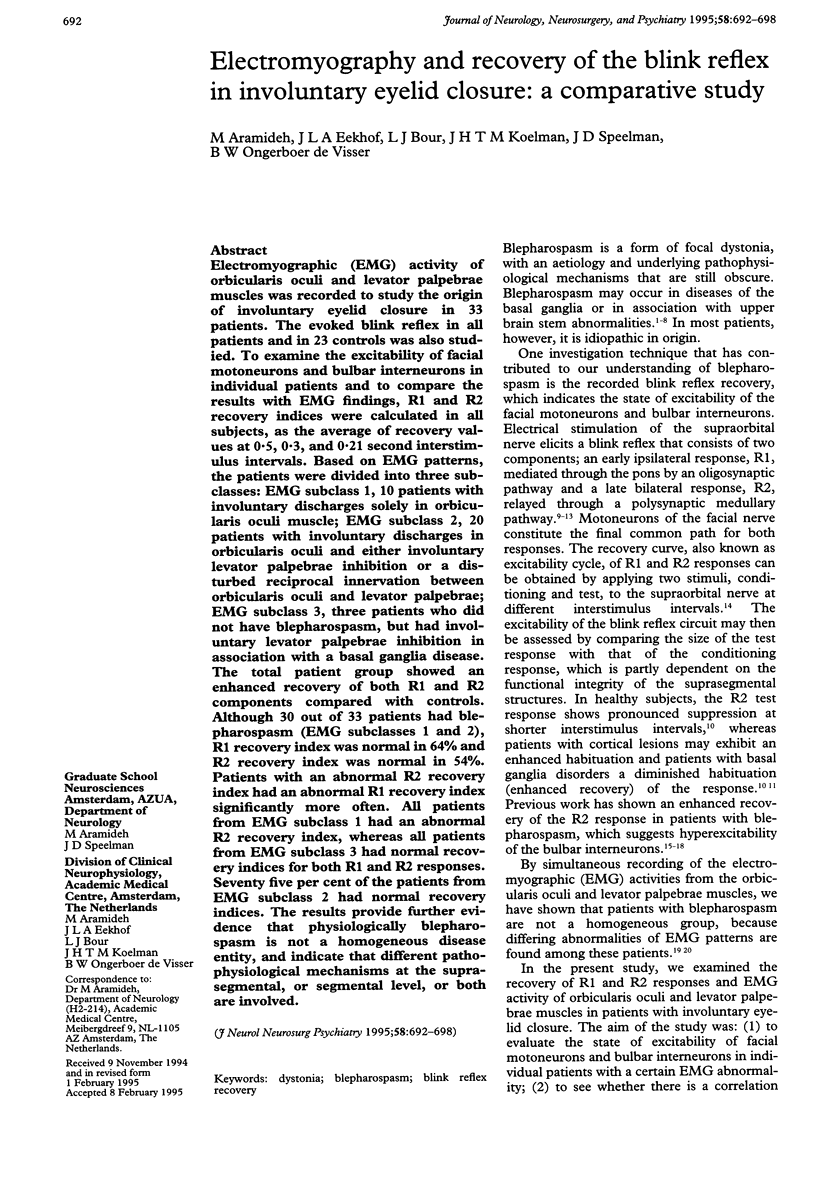
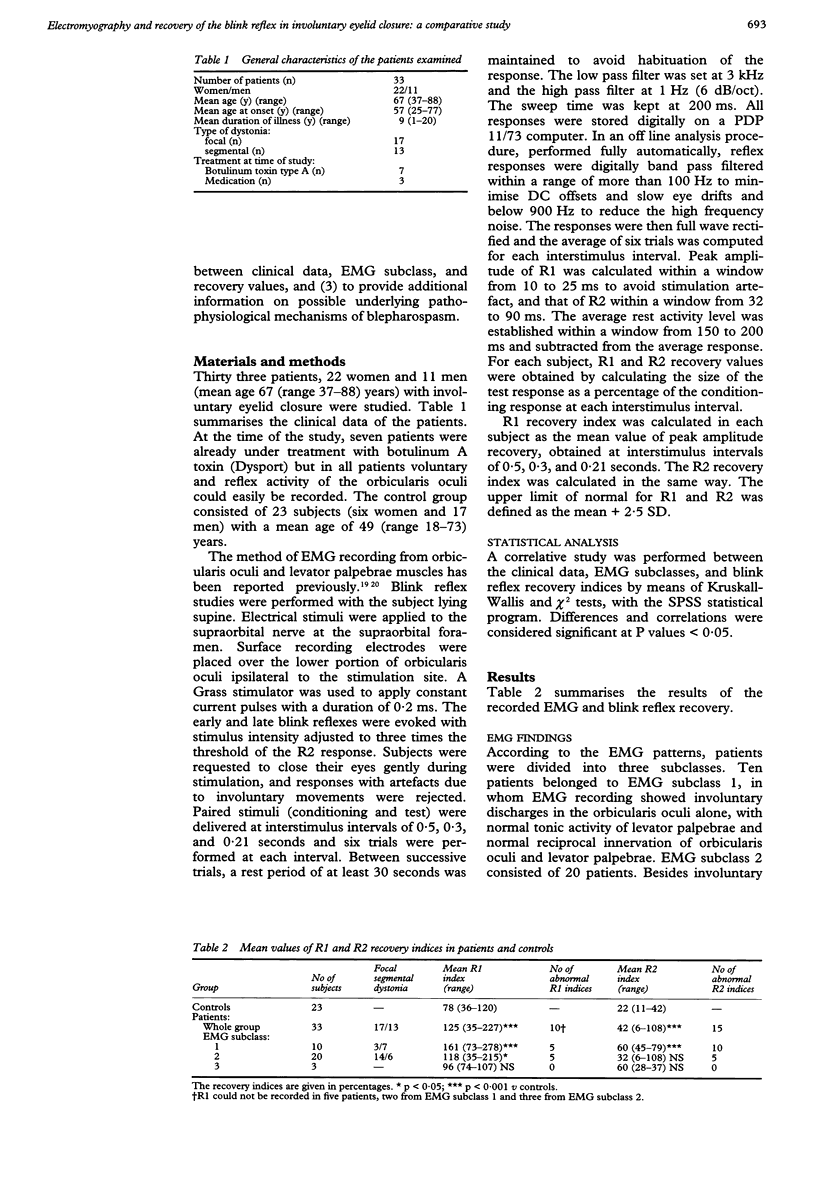
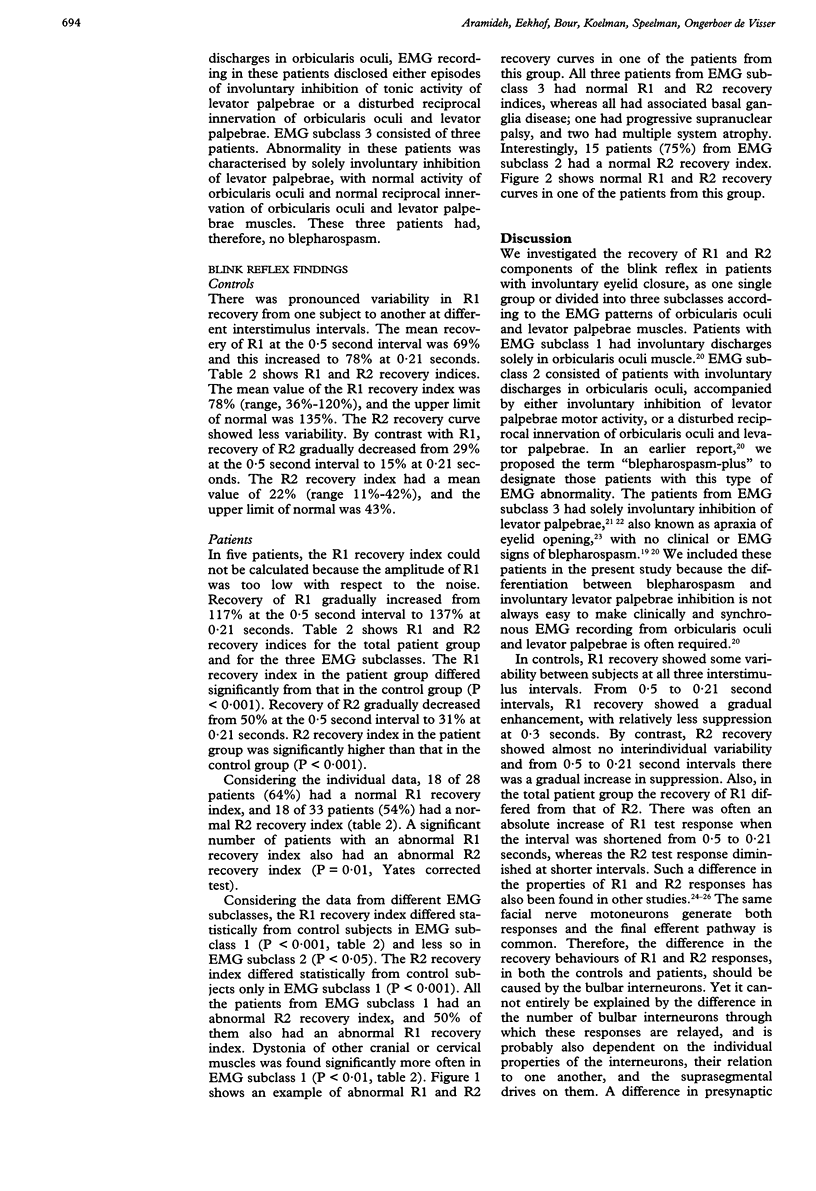
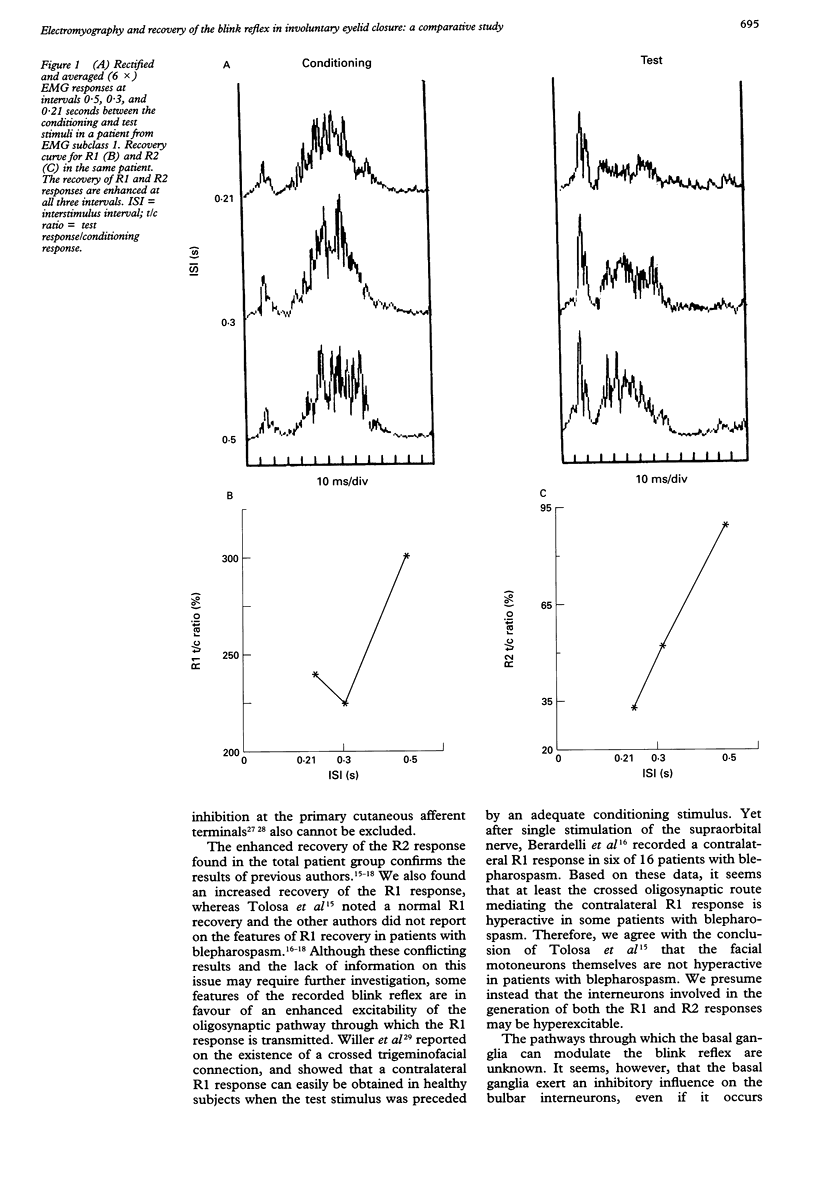
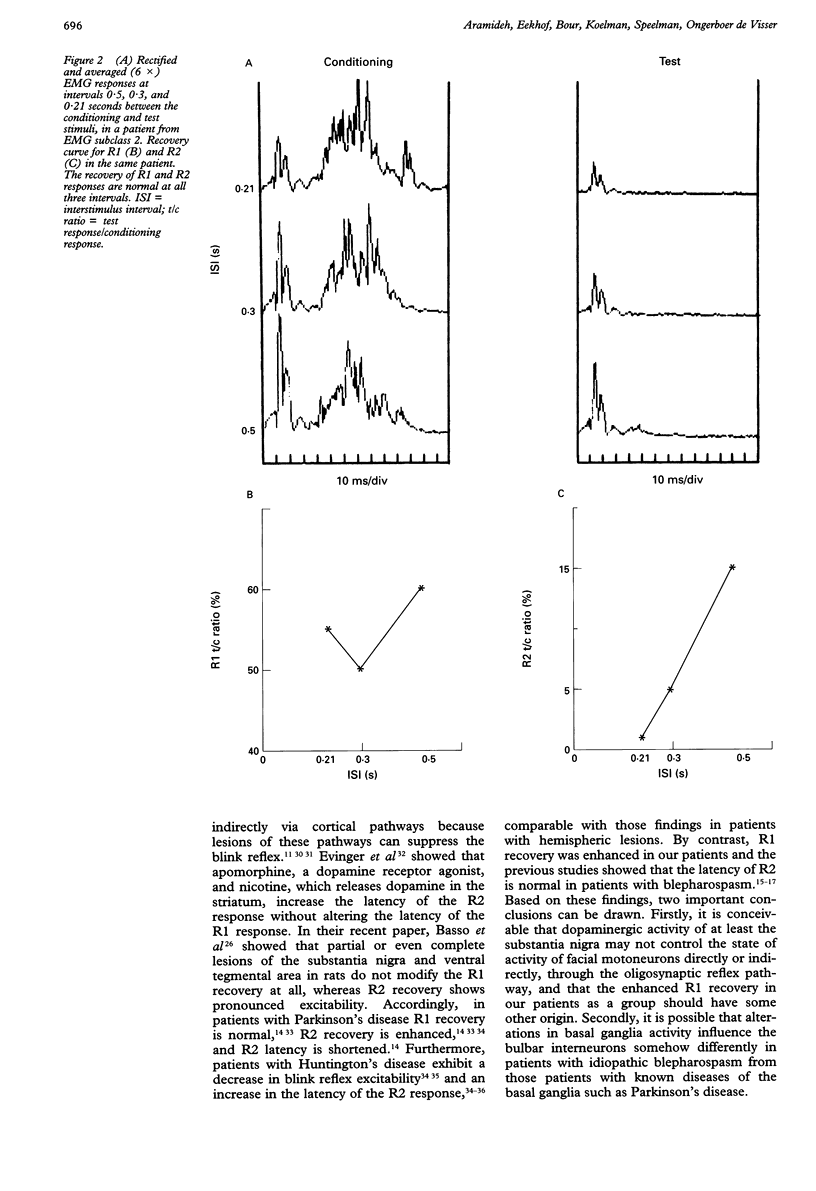
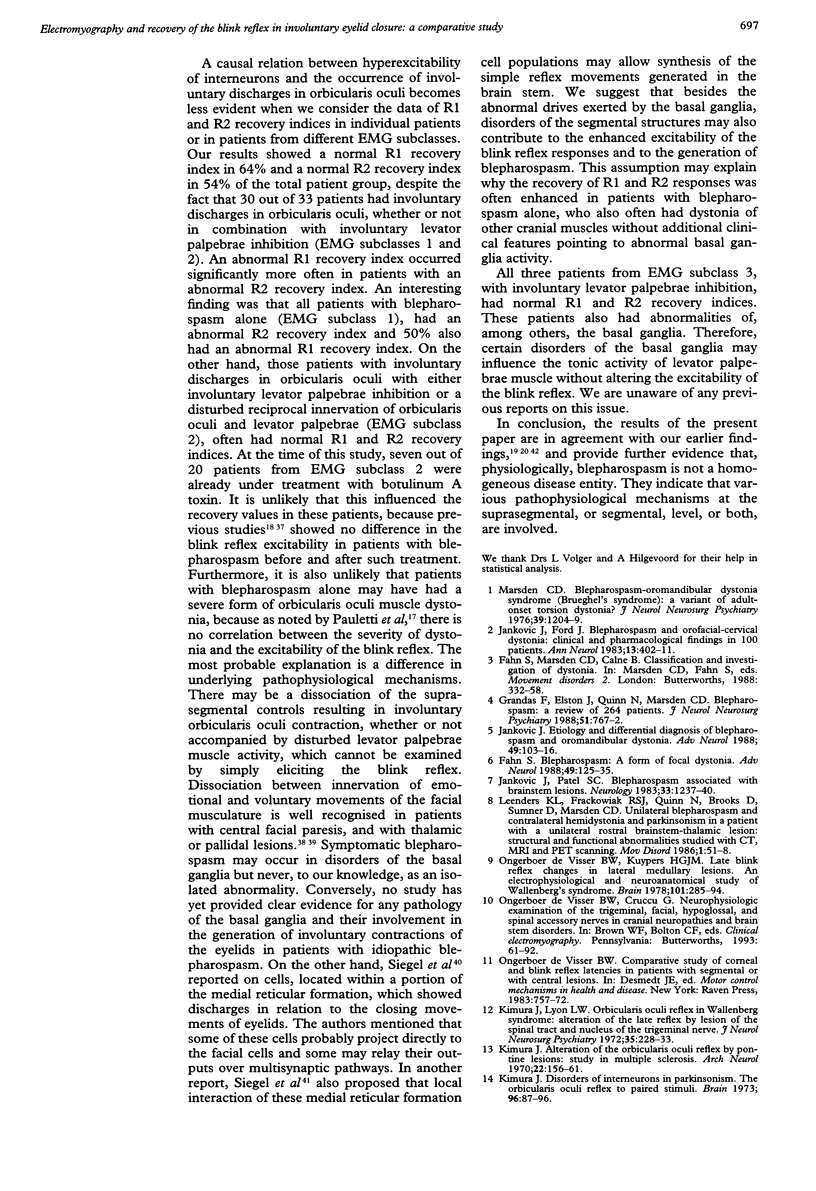
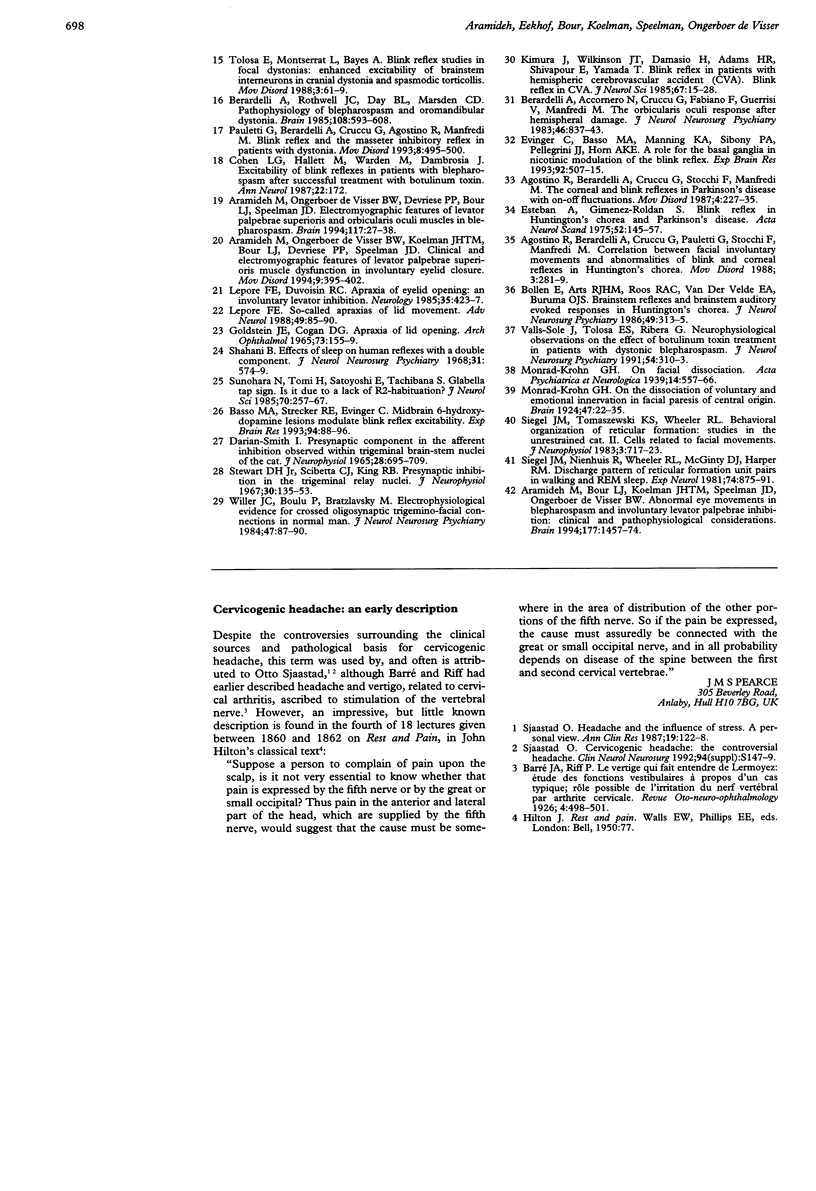
Selected References
These references are in PubMed. This may not be the complete list of references from this article.
- Agostino R., Berardelli A., Cruccu G., Pauletti G., Stocchi F., Manfredi M. Correlation between facial involuntary movements and abnormalities of blink and corneal reflexes in Huntington's chorea. Mov Disord. 1988;3(4):281–289. doi: 10.1002/mds.870030401. [DOI] [PubMed] [Google Scholar]
- Agostino R., Berardelli A., Cruccu G., Stocchi F., Manfredi M. Corneal and blink reflexes in Parkinson's disease with "on-off" fluctuations. Mov Disord. 1987;2(4):227–235. doi: 10.1002/mds.870020401. [DOI] [PubMed] [Google Scholar]
- Aramideh M., Bour L. J., Koelman J. H., Speelman J. D., Ongerboer de Visser B. W. Abnormal eye movements in blepharospasm and involuntary levator palpebrae inhibition. Clinical and pathophysiological considerations. Brain. 1994 Dec;117(Pt 6):1457–1474. doi: 10.1093/brain/117.6.1457. [DOI] [PubMed] [Google Scholar]
- Aramideh M., Ongerboer de Visser B. W., Devriese P. P., Bour L. J., Speelman J. D. Electromyographic features of levator palpebrae superioris and orbicularis oculi muscles in blepharospasm. Brain. 1994 Feb;117(Pt 1):27–38. doi: 10.1093/brain/117.1.27. [DOI] [PubMed] [Google Scholar]
- Aramideh M., Ongerboer de Visser B. W., Koelman J. H., Bour L. J., Devriese P. P., Speelman J. D. Clinical and electromyographic features of levator palpebrae superioris muscle dysfunction in involuntary eyelid closure. Mov Disord. 1994 Jul;9(4):395–402. doi: 10.1002/mds.870090404. [DOI] [PubMed] [Google Scholar]
- Basso M. A., Strecker R. E., Evinger C. Midbrain 6-hydroxydopamine lesions modulate blink reflex excitability. Exp Brain Res. 1993;94(1):88–96. doi: 10.1007/BF00230472. [DOI] [PubMed] [Google Scholar]
- Berardelli A., Accornero N., Cruccu G., Fabiano F., Guerrisi V., Manfredi M. The orbicularis oculi response after hemispheral damage. J Neurol Neurosurg Psychiatry. 1983 Sep;46(9):837–843. doi: 10.1136/jnnp.46.9.837. [DOI] [PMC free article] [PubMed] [Google Scholar]
- Berardelli A., Rothwell J. C., Day B. L., Marsden C. D. Pathophysiology of blepharospasm and oromandibular dystonia. Brain. 1985 Sep;108(Pt 3):593–608. doi: 10.1093/brain/108.3.593. [DOI] [PubMed] [Google Scholar]
- Bollen E., Arts R. J., Roos R. A., van der Velde E. A., Buruma O. J. Brainstem reflexes and brainstem auditory evoked responses in Huntington's chorea. J Neurol Neurosurg Psychiatry. 1986 Mar;49(3):313–315. doi: 10.1136/jnnp.49.3.313. [DOI] [PMC free article] [PubMed] [Google Scholar]
- DARIAN-SMITH I. PRESYNAPTIC COMPONENT IN THE AFFERENT INHIBITION OBSERVED WITHIN TRIGEMINAL BRAIN-STEM NUCLEI OF THE CAT. J Neurophysiol. 1965 Jul;28:695–709. doi: 10.1152/jn.1965.28.4.695. [DOI] [PubMed] [Google Scholar]
- Esteban A., Giménez-Roldàn S. Blink reflex in Huntingon's chorea and Parkinson's disease. Acta Neurol Scand. 1975 Aug;52(2):145–157. doi: 10.1111/j.1600-0404.1975.tb05768.x. [DOI] [PubMed] [Google Scholar]
- Evinger C., Basso M. A., Manning K. A., Sibony P. A., Pellegrini J. J., Horn A. K. A role for the basal ganglia in nicotinic modulation of the blink reflex. Exp Brain Res. 1993;92(3):507–515. doi: 10.1007/BF00229040. [DOI] [PubMed] [Google Scholar]
- Fahn S. Blepharospasm: a form of focal dystonia. Adv Neurol. 1988;49:125–133. [PubMed] [Google Scholar]
- GOLDSTEIN J. E., COGAN D. G. APRAXIA OF LID OPENING. Arch Ophthalmol. 1965 Feb;73:155–159. doi: 10.1001/archopht.1965.00970030157003. [DOI] [PubMed] [Google Scholar]
- Grandas F., Elston J., Quinn N., Marsden C. D. Blepharospasm: a review of 264 patients. J Neurol Neurosurg Psychiatry. 1988 Jun;51(6):767–772. doi: 10.1136/jnnp.51.6.767. [DOI] [PMC free article] [PubMed] [Google Scholar]
- Jankovic J. Etiology and differential diagnosis of blepharospasm and oromandibular dystonia. Adv Neurol. 1988;49:103–116. [PubMed] [Google Scholar]
- Jankovic J., Ford J. Blepharospasm and orofacial-cervical dystonia: clinical and pharmacological findings in 100 patients. Ann Neurol. 1983 Apr;13(4):402–411. doi: 10.1002/ana.410130406. [DOI] [PubMed] [Google Scholar]
- Jankovic J., Patel S. C. Blepharospasm associated with brainstem lesions. Neurology. 1983 Sep;33(9):1237–1240. doi: 10.1212/wnl.33.9.1237. [DOI] [PubMed] [Google Scholar]
- Kimura J. Alteration of the orbicularis oculi reflex by pontine lesions. Study in multiple sclerosis. Arch Neurol. 1970 Feb;22(2):156–161. doi: 10.1001/archneur.1970.00480200062006. [DOI] [PubMed] [Google Scholar]
- Kimura J. Disorder of interneurons in Parkinsonism. The orbicularis oculi reflex to paired stimuli. Brain. 1973;96(1):87–96. doi: 10.1093/brain/96.1.87. [DOI] [PubMed] [Google Scholar]
- Kimura J., Lyon L. W. Orbicularis oculi reflex in the Wallenberg syndrome: alteration of the late reflex by lesions of the spinal tract and nucleus of the trigeminal nerve. J Neurol Neurosurg Psychiatry. 1972 Apr;35(2):228–233. doi: 10.1136/jnnp.35.2.228. [DOI] [PMC free article] [PubMed] [Google Scholar]
- Kimura J., Wilkinson J. T., Damasio H., Adams H. R., Jr, Shivapour E., Yamada T. Blink reflex in patients with hemispheric cerebrovascular accident (CVA). Blink reflex in CVA. J Neurol Sci. 1985 Jan;67(1):15–28. doi: 10.1016/0022-510x(85)90018-8. [DOI] [PubMed] [Google Scholar]
- Leenders K. L., Frackowiak R. S., Quinn N., Brooks D., Sumner D., Marsden C. D. Ipsilateral blepharospasm and contralateral hemidystonia and parkinsonism in a patient with a unilateral rostral brainstem-thalamic lesion: structural and functional abnormalities studied with CT, MRI, and PET scanning. Mov Disord. 1986;1(1):51–58. doi: 10.1002/mds.870010107. [DOI] [PubMed] [Google Scholar]
- Lepore F. E., Duvoisin R. C. "Apraxia" of eyelid opening: an involuntary levator inhibition. Neurology. 1985 Mar;35(3):423–427. doi: 10.1212/wnl.35.3.423. [DOI] [PubMed] [Google Scholar]
- Lepore F. E. So-called apraxias of lid movement. Adv Neurol. 1988;49:85–90. [PubMed] [Google Scholar]
- Marsden C. D. Blepharospasm-oromandibular dystonia syndrome (Brueghel's syndrome). A variant of adult-onset torsion dystonia? J Neurol Neurosurg Psychiatry. 1976 Dec;39(12):1204–1209. doi: 10.1136/jnnp.39.12.1204. [DOI] [PMC free article] [PubMed] [Google Scholar]
- Ongerboer de Visser B. W. Comparative study of corneal and blink reflex latencies in patients with segmental or with cerebral lesions. Adv Neurol. 1983;39:757–772. [PubMed] [Google Scholar]
- Ongerboer de Visser B. W., Kuypers H. G. Late blink reflex changes in lateral medullary lesions. An electrophysiological and neuro-anatomical study of Wallenberg's Syndrome. Brain. 1978 Jun;101(2):285–294. doi: 10.1093/brain/101.2.285. [DOI] [PubMed] [Google Scholar]
- Pauletti G., Berardelli A., Cruccu G., Agostino R., Manfredi M. Blink reflex and the masseter inhibitory reflex in patients with dystonia. Mov Disord. 1993 Oct;8(4):495–500. doi: 10.1002/mds.870080414. [DOI] [PubMed] [Google Scholar]
- Shahani B. Effects of sleep on human reflexes with a double component. J Neurol Neurosurg Psychiatry. 1968 Dec;31(6):574–579. doi: 10.1136/jnnp.31.6.574. [DOI] [PMC free article] [PubMed] [Google Scholar]
- Siegel J. M., Nienhuis R., Wheeler R. L., McGinty D. J., Harper R. M. Discharge pattern of reticular formation unit pairs in waking and REM sleep. Exp Neurol. 1981 Dec;74(3):875–891. doi: 10.1016/0014-4886(81)90260-0. [DOI] [PMC free article] [PubMed] [Google Scholar]
- Siegel J. M., Tomaszewski K. S., Wheeler R. L. Behavioral organization of reticular formation: studies in the unrestrained cat. II. Cells related to facial movements. J Neurophysiol. 1983 Sep;50(3):717–723. doi: 10.1152/jn.1983.50.3.717. [DOI] [PMC free article] [PubMed] [Google Scholar]
- Sunohara N., Tomi H., Satoyoshi E., Tachibana S. Glabella tap sign. Is it due to a lack of R2-habituation? J Neurol Sci. 1985 Oct;70(3):257–267. doi: 10.1016/0022-510x(85)90167-4. [DOI] [PubMed] [Google Scholar]
- Tolosa E., Montserrat L., Bayes A. Blink reflex studies in focal dystonias: enhanced excitability of brainstem interneurons in cranial dystonia and spasmodic torticollis. Mov Disord. 1988;3(1):61–69. doi: 10.1002/mds.870030108. [DOI] [PubMed] [Google Scholar]
- Valls-Sole J., Tolosa E. S., Ribera G. Neurophysiological observations on the effects of botulinum toxin treatment in patients with dystonic blepharospasm. J Neurol Neurosurg Psychiatry. 1991 Apr;54(4):310–313. doi: 10.1136/jnnp.54.4.310. [DOI] [PMC free article] [PubMed] [Google Scholar]
- Willer J. C., Boulu P., Bratzlavsky M. Electrophysiological evidence for crossed oligosynaptic trigemino-facial connections in normal man. J Neurol Neurosurg Psychiatry. 1984 Jan;47(1):87–90. doi: 10.1136/jnnp.47.1.87. [DOI] [PMC free article] [PubMed] [Google Scholar]


